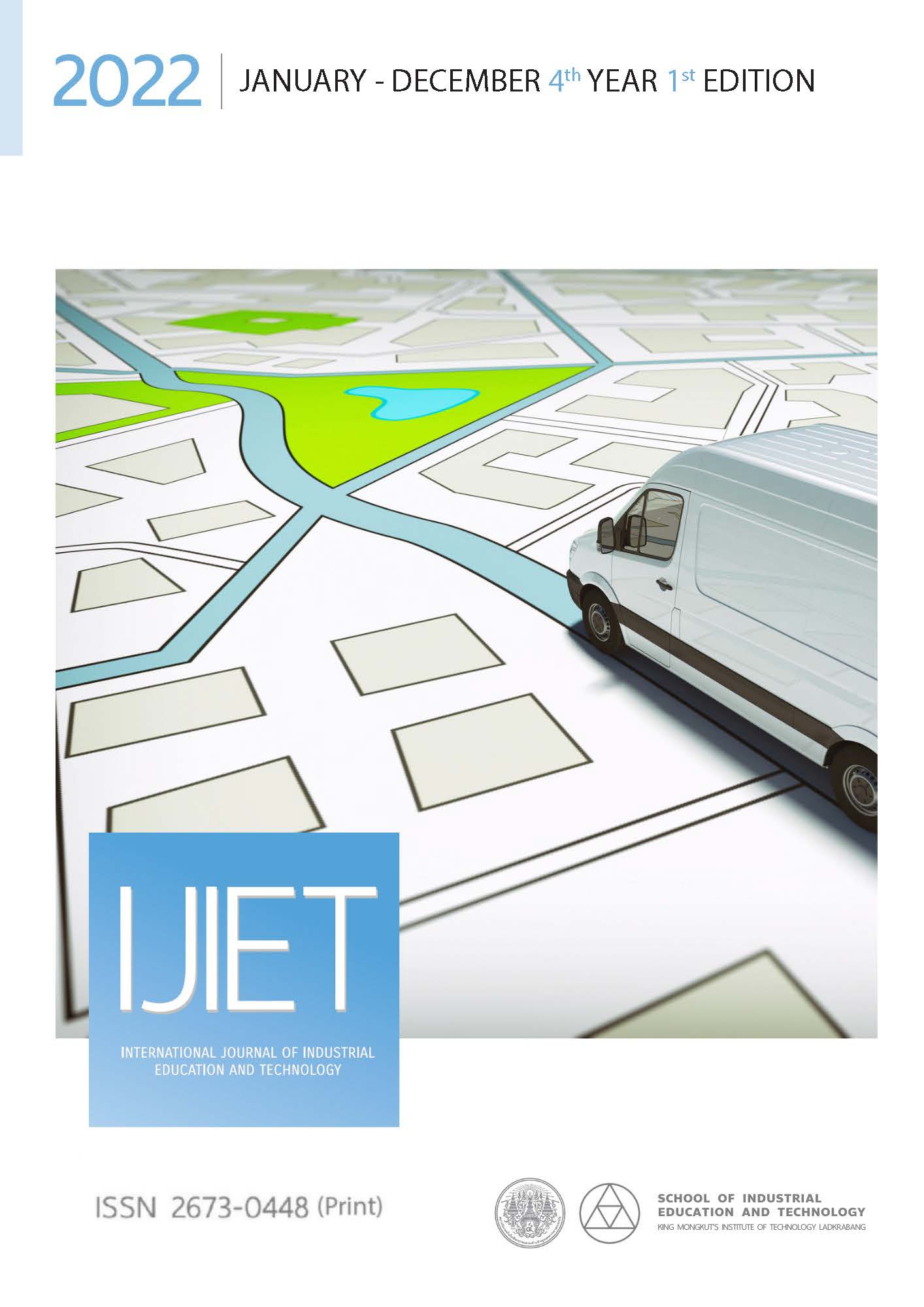STUDY AND ANALYSIS ON TOTAL ELECTRON CONTENT IN SEISMO-IONOSPHERIC COUPLING FOR EARTHQUAKE MONITORING IN THAILAND
Keywords:
Earthquake, TEC, IGS TEC, IRI TEC, CorrelationAbstract
This research shows the study and analysis on the relationship between earthquake events and the Total Electron Content (TEC) of the ionosphere over Thailand during 2007-2020. The method for this research is to use the International GNSS Service (IGS) network and the International Reference Ionosphere (IRI) model for finding TEC in the ionosphere and analyze the correlation on earthquake events and ionosphere characteristics. The result is correlated between IGS TEC and earthquake events at 0.089, which shows the positive evidence of correlation on earthquake magnitudes and ionosphere. The relationship between IRI TEC and earthquake events correlates at 0.056, which shows the positive correlation between earthquake events and ionosphere. A significant correlation among IGS TEC, IRI TEC, and earthquake events obviously showed direct evidence of correlation coefficient on ionosphere disturbance and earthquake magnitudes at 5.0 and upward magnitudes. As the results, it guides to making the future work and the researchers will study the significance of the development of earthquake warning systems.
References
Afraimovich, E. L., Astafieva, E. I., Gokhberg, M. B., Lapshin, V. M., Permyakova, V. E., Steblov, G. M., & Shalimov, S. L. (2004). Variations of the total electron content in the ionosphere from GPS data recorded during the Hector Mine earthquake of October 16, 1999, California. Russian Journal of Earth Sciences, 6(5), 339-354.
Arikan, F., Nayir, H., Sezen, U., & Arikan, O. (2008). Estimation of single station interfrequency receiver bias using GPS-TEC. Radio Science, 43(4), 1-13.
Blewitt, G. (1990). An automatic editing algorithm for GPS data. Geophysical Research Letters, 17(3), 199-202.
Cahyadi, M. N., & Heki, K. (2013). Ionospheric disturbances of the 2007 Bengkulu and the 2005 Nias earthquakes, Sumatra, observed with a regional GPS network. Journal of Geophysical Research: Space Physics, 118(4), 1777-1787.
Grawe, M. A., & Makela, J. J. (2015). The ionospheric responses to the 2011 Tohoku, 2012 Haida Gwaii, and 2010 Chile tsunamis: Effects of tsunami orientation and observation geometry. Earth and Space Science, 2(11), 472-483.
Heki, K. (2011). Ionospheric electron enhancement preceding the 2011 Tohoku Oki earthquake. Geophysical Research Letters, 38(17), 1-5.
Heki, K. (2022). Ionospheric signatures of repeated passages of atmospheric waves by the 2022 Jan, 15 Hunga Tonga-Hunga Ha’apai eruption detected by QZSS-TEC observations in Japan. Earth, Planets and Space, 74, 1-12.
International GNSS Service. (1998). Ionospheric Products. https://igs.org/products/#ionosphere
Kakinami, Y., Saito, H., Yamamoto, T., Chen, C.-H., Yamamoto, M.-Y., Nakajima, K., Liu, J.-Y., & Watanabe, S. (2021). Onset Altitudes of co-seismic ionospheric disturbances determined by multiple distributions of GNSS TEC after the foreshock of the 2011 Tohoku earthquake on March 9, 2011. Earth and Space Science, 8, 1-12.
Kenpankho, P., Chaichana, A., Trachu, K., Supnithi, P., & Hozumi, K. (2021). Real-time GPS receiver bias estimation. Advances in Space Research, 68(5), 2152-2159.
Kenpankho, P., Supnithi, P., & Nagatsuma, T. (2013). Comparison of observed TEC values with IRI-2007 TEC and IRI-2007 TEC with optional foF2 measurements predictions at an equatorial region, Chumphon, Thailand. Advances in Space Research, 52(10), 1820-1826.
Kenpankho, P., Watthanasangmechai, K., Supnithi, P., Tsugawa, T., & Maruyama, T. (2011). Comparison of GPS TEC measurements with IRI TEC prediction at the equatorial latitude station Chumphon, Thailand. Earth Planets Space, 63(4), 365-370.
Kiyani, A., Shah, M., Ahmed, A., Shah, H. H., Hameed, S., Adil, M. A., & Naqvi, N. A. (2020). Seismo ionospheric anomalies possibly associated with the 2018 Mw 8.2 Fiji earthquake detected with GNSS TEC. Journal of Geodynamics, 140,1-8.
Liu, J. Y., Chuo, Y. J., Shan, S. J., Tsai, Y. B., Chen, Y. I., Pulinets, S. A., & Yu, S. B. (2004). Pre-earthquake ionospheric anomalies registered by continuous GPS TEC measurements. Annales Geophysicae, 22(5), 1585-1593.
Ma, G., & Maruyama, T. (2003). Derivation of TEC and estimation of instrumental biases from GEONET in Japan. Annales Geophysicae, 21(10), 2083-2093.
Mukaka, M. M. (2012). A guide to appropriate use of correlation coefficient in medical research. Malawi Medical Journal, 24(3), 69-71.
National Aeronautics and Space Administration. (2022). International Reference Ionosphere - IRI (2016) with IGRF-13 coefficients. Community Coordinated Modeling Center (CCMC). https://ccmc.gsfc.nasa.gov/modelweb/models/iri2016_vitmo.php
Nishioka, M., Saito, S., Tao, C., Shiota, D., Tsugawa, T., & Ishii, M. (2021). Statistical analysis of ionospheric total electron content (TEC): long-term estimation of extreme TEC in Japan. Earth, Planets and Space, 73(1), 1-12.
Ouzounov, D., Pulinets, S., Romanov, A., Tsybulya, K., Davidenko, D., Kafatos, M., & Taylor, P. (2011). Atmosphere-ionosphere response to the M9 Tohoku earthquake revealed by multi-instrument space-borne and ground observations: Preliminary results. Earthquake Science, 24, 557-564.
Pulinets, S. (2004). Ionospheric precursors of earthquakes; recent advances in theory and practical applications. Terrestrial Atmospheric and Oceanic Sciences, 15(3), 413-436.
Pulinets, S. A., Contreras, A. L., Bisiacchi-Giraldi, G., & Ciraolo, L. (2005). Total electron content variations in the ionosphere before the Colima, Mexico, earthquake of 21 January 2003. Geofísica Internacional, 44(4), 369-377.
Priyadarshi, S., Kumar, S., & Singh, A. K. (2011). Changes in total electron content associated with earthquakes (M> 5) observed from GPS station, Varanasi, India. Geomatics, Natural Hazards and Risk, 2(2), 123-139.
Shah, M., & Jin, S. (2015). Statistical characteristics of seismo-ionospheric GPS TEC disturbances prior to global Mw ≥ 5.0 earthquakes (1998-2014). Journal of Geodynamics, 92, 42-49.
Shah, M., Ahmed, A., Ehsan, M., Khan, M., Tariq, M. A., Calabia, A., & Rahman, Z. U. (2020). Total electron content anomalies associated with earthquakes occurred during 1998-2019. Acta Astronautica, 175, 268-276.
Sharma, G., Soubam, M., Walia, D., Nishant, N., Sarma, K. K., & Raju, P. L. N. (2021). Development of a monitoring system for ionospheric TEC variability before the earthquakes. Applied Computing and Geosciences, 9, 1-7.
Thai Meteorological Department. (2007). Local earthquake. https://earthquake.tmd.go.th/inside.html?pageNum_thaievent=0&totalRows_thaievent=10454
Ulukavaka, M., & Inyurtb, S. (2020). Seismo-ionospheric precursors of strong sequential earthquakes in Nepal region. Acta Astronautica, 166, 123-130.
Downloads
Published
Issue
Section
License
Copyright (c) 2023 International Journal of Industrial Education and Technology

This work is licensed under a Creative Commons Attribution-NonCommercial-NoDerivatives 4.0 International License.



